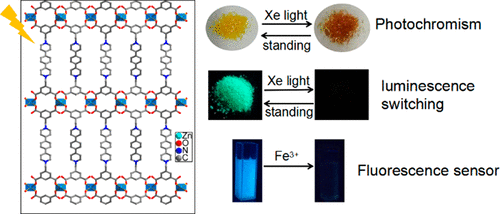当前位置:
X-MOL 学术
›
Cryst. Growth Des.
›
论文详情
Our official English website, www.x-mol.net, welcomes your
feedback! (Note: you will need to create a separate account there.)
Metal–Organic Frameworks with Extended Viologen Units: Metal-Dependent Photochromism, Photomodulable Fluorescence, and Sensing Properties
Crystal Growth & Design ( IF 3.2 ) Pub Date : 2018-10-09 00:00:00 , DOI: 10.1021/acs.cgd.8b01383 Peng Li 1 , Li-Jiao Zhou 1 , Ning-Ning Yang 1 , Qi Sui 1 , Teng Gong 1 , En-Qing Gao 1
Crystal Growth & Design ( IF 3.2 ) Pub Date : 2018-10-09 00:00:00 , DOI: 10.1021/acs.cgd.8b01383 Peng Li 1 , Li-Jiao Zhou 1 , Ning-Ning Yang 1 , Qi Sui 1 , Teng Gong 1 , En-Qing Gao 1
Affiliation

|
The photoresponsive viologen unit has been widely used to endow metal–organic materials with photochromic and other photomodulable properties. Herein we report the first examples of the metal–organic materials functionalized by extended viologens (ExVs), of general formula [ML]·2H2O (M = Zn for 1, M = Mn for 2, M = Co for 3, and L is a tetracarboxylate ligand with the p-phenylene-extended viologen spacer). Of the three isomorphic metal–organic frameworks, only 1 is photochromic owing to formation of extended viologen radicals through photoinduced electron transfer (PET). The incapability of 2 and 3 to undergo photochromism can be ascribed to longer intermolecular donor–acceptor contacts, emphasizing the sensitivity of solid-state PET to structural changes. 1 also shows strong fluorescence owing to interligand charge transfer, and the fluorescence can be reversibly modulated and switched on/off in the photochromic process. Furthermore, 1 shows excellent hydrolytic stability and can be used as a sensitive, selective, and recyclable fluorescence sensor for detecting Fe3+ in water. The results demonstrated the great potential of extended viologens as functional units for the design of novel responsive metal–organic materials.
中文翻译:

具有扩展的紫罗兰色单位的金属有机框架:取决于金属的光致变色,可光调制的荧光和传感特性
光响应性紫精装置已被广泛用于赋予金属有机材料具有光致变色和其他可光调制特性。在这里,我们报告由扩展紫精(ExVs)功能化的金属有机材料的第一个示例,通式为[ML]·2H 2 O(M = Zn表示1,M = Mn表示2,M = Co表示3,以及L是具有对-亚苯基-延伸的紫精间隔基的四羧酸酯配体。在三种同构的金属有机框架中,只有1种是光致变色的,这是由于通过光致电子转移(PET)形成了扩展的紫罗兰自由基所致。2和3的能力不足经历光致变色现象可归因于较长的分子间供体-受体接触,强调了固态PET对结构变化的敏感性。图1还显示出由于配体电荷转移而产生的强荧光,并且可以在光致变色过程中可逆地调制和打开/关闭荧光。此外,1具有极好的水解稳定性,可以用作检测水中Fe 3+的灵敏,选择性和可回收的荧光传感器。结果表明,扩展紫精作为功能单元可用于设计新颖的响应性金属有机材料。
更新日期:2018-10-09
中文翻译:

具有扩展的紫罗兰色单位的金属有机框架:取决于金属的光致变色,可光调制的荧光和传感特性
光响应性紫精装置已被广泛用于赋予金属有机材料具有光致变色和其他可光调制特性。在这里,我们报告由扩展紫精(ExVs)功能化的金属有机材料的第一个示例,通式为[ML]·2H 2 O(M = Zn表示1,M = Mn表示2,M = Co表示3,以及L是具有对-亚苯基-延伸的紫精间隔基的四羧酸酯配体。在三种同构的金属有机框架中,只有1种是光致变色的,这是由于通过光致电子转移(PET)形成了扩展的紫罗兰自由基所致。2和3的能力不足经历光致变色现象可归因于较长的分子间供体-受体接触,强调了固态PET对结构变化的敏感性。图1还显示出由于配体电荷转移而产生的强荧光,并且可以在光致变色过程中可逆地调制和打开/关闭荧光。此外,1具有极好的水解稳定性,可以用作检测水中Fe 3+的灵敏,选择性和可回收的荧光传感器。结果表明,扩展紫精作为功能单元可用于设计新颖的响应性金属有机材料。


















































 京公网安备 11010802027423号
京公网安备 11010802027423号